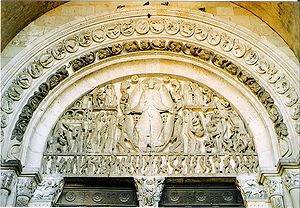
Gislebertus
Encyclopedia

Autun
Autun is a commune in the Saône-et-Loire department in Burgundy in eastern France. It was founded during the early Roman Empire as Augustodunum. Autun marks the easternmost extent of the Umayyad campaign in Europe.-Early history:...
, France
France
The French Republic , The French Republic , The French Republic , (commonly known as France , is a unitary semi-presidential republic in Western Europe with several overseas territories and islands located on other continents and in the Indian, Pacific, and Atlantic oceans. Metropolitan France...
- consisting of numerous doorways, tympanums
Tympanum (architecture)
In architecture, a tympanum is the semi-circular or triangular decorative wall surface over an entrance, bounded by a lintel and arch. It often contains sculpture or other imagery or ornaments. Most architectural styles include this element....
, and capitals - represents some of the most original work of the period. His sculpture is expressive and imaginative: from the terrifying Last Judgment (West Tympanum), with its strikingly elongated figures, to the Eve (North Portal), the first large scale nude in European art since antiquity and a model of sinuous grace. His influence can be traced to other French church sculpture, and his techniques helped pave the way for the Gothic style.
The name Gislebertus, the Latin for "Gilbert" (and for other "Gilberts" more usually spelt as the variants above), is found carved on the west tympanum of Autun Cathedral: "Gislebertus hoc fecit" or "Gislebertus made this." Some scholars today believe that this is actually the name of the patron who commissioned the work, rather than that of the artist. The lead sculptor would in any case have had a number of assistants, though the distinctive designs may well have been the work of a single hand. Gislebertus' name is the first ever found on stone work from the Romanesque period, as the sculptors before him believed themselves to be working for God, instead of themselves being creative individuals.

